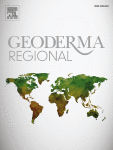Ver ítem
- xmlui.general.dspace_homeCentros Regionales y EEAsCentro Regional La Pampa - San LuisEEA AnguilArtículos científicosxmlui.ArtifactBrowser.ItemViewer.trail
- Inicio
- Centros Regionales y EEAs
- Centro Regional La Pampa - San Luis
- EEA Anguil
- Artículos científicos
- Ver ítem
Soil quality and productivity under zero tillage and grazing on Mollisols in Argentina – A long-term study
Resumen
The growing global demand for food, fibers and energy has triggered a scientific and political debate on how to attain increasing land productivity without further degrading soils. The objective of this study was to quantify the effect of long-term no-till cultivation with light grazing on soil quality, land productivity, and resource use efficiency. The experiment was established in 1993 with two main treatments, no-till (NT) and conventional tillage
[ver mas...]
The growing global demand for food, fibers and energy has triggered a scientific and political debate on how to attain increasing land productivity without further degrading soils. The objective of this study was to quantify the effect of long-term no-till cultivation with light grazing on soil quality, land productivity, and resource use efficiency. The experiment was established in 1993 with two main treatments, no-till (NT) and conventional tillage (CT), sub-divided into grazed and ungrazed subplots, in a paired strip design with three repetitions. Crops included sunflower, corn, soy and wheat, and stubbles were grazed for at 3 months with young animals. Soil samples were collected in 2015 and determinations included total carbon and its fractions, total nitrogen, microbial biomass carbon, soil moisture contents, aggregate size class distribution, volumetric aggregate weight, mean weight diameter change, maximum bulk density, total infiltration, and saturated hydraulic conductivity. Crop production was on average 13% higher in NT than in CT, and grazing had no effect on yields. NT increased organic matter contents by 6% and CT diminished it by 1.7% in the top 0.10 m compared to the original value in 1993, and showed no significant variation at 0.10–0.20 m depth. The labile C fractions and microbial biomass carbon showed a similar trend with highest values in the non-grazed NT topsoil. We found positive relationships between microbial biomass and labile carbon and nitrogen fractions only for the NT soils. All soil physical quality indicators had better values for NT compared to CT soils, and grazing had no effect. The results of this long-term experiment gave evidence that a NT system with light grazing was a feasible land management that increased land productivity in a semiarid environment.
[Cerrar]

Autor
Fuente
Geoderma Regional 11 : 44-52. ( December 2017)
Fecha
2017-12
ISSN
2352-0094
Formato
pdf
Tipo de documento
article
Palabras Claves
Derechos de acceso
Restringido
 Excepto donde se diga explicitamente, este item se publica bajo la siguiente descripción: Creative Commons Attribution-NonCommercial-ShareAlike 2.5 Unported (CC BY-NC-SA 2.5)
Excepto donde se diga explicitamente, este item se publica bajo la siguiente descripción: Creative Commons Attribution-NonCommercial-ShareAlike 2.5 Unported (CC BY-NC-SA 2.5)

